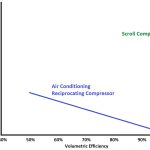Understanding Service Compressor Replacements
This is part 1 of a 3 part series on understanding service compressor replacements.
What is re-expansion gas and how does it affect compressors?
It is important for contractors to understand why compressor capacities change at different system conditions and know what steps to take when servicing or replacing compressors. There are several types of mechanical compression used around the world in air conditioning applications available today: rotary, screw, reciprocating and scroll, just to name a few. The focus in this series will be on reciprocating (piston) compression and how this style of mechanical compression relates to scroll compression.
Volumetric Efficiency:
Simply defined, volumetric efficiency is the ratio of the amount of refrigerant gas entering the compressor (suction) versus the amount of gas leaving the compressor (discharge). For example, if the compression cycle is 100% efficient, it means that all of the gas coming into the compressor’s suction fitting is traveling through the system and leaving the compressor’s discharge fitting. Volumetric efficiency is typically expressed as a percent, using the formula volume pumped divided by displacement.
Because of the limitations on clearances in reciprocating compressors, (the area between the top of the piston and bottom of the valve plate) there is always a small amount of re-expansion gas left behind in the cylinder. Even at top center of the discharge stroke, a small amount of gas still remains. This gas occupies the space between the top of the piston/valve plate and in most cases, the discharge port(s) must re-expand upon returning to the suction stroke of the compression process. This volume of gas (clearance volume) reduces the overall volumetric efficiency incrementally as it grows.
Scroll compressors are more efficient because they don’t use pistons, reeds, or valves. When the first pocket of the scroll set closes and captures a volume of refrigerant, all of it is swept along in the compression process and discharged out of the scroll members to the system. Unlike piston compressors, there is no clearance area or clearance volume to create losses; thus, scroll compressors are theoretically considered 100% efficient.
The chart below may provide a clearer picture. The bottom of this chart (X axis) represents the “volumetric efficiency”—expressed on the chart as a percent. Within the X and Y axis of the chart, the green line represents a scroll compressor’s efficiency, while the blue line represents a reciprocating (piston) compressor. The left side of the chart (Y Axis) expresses the compression ratio (absolute discharge divided by absolute suction).
In the next installment, we’ll discuss compression ratio as we continue our journey to better understanding proper service compressor replacements.



